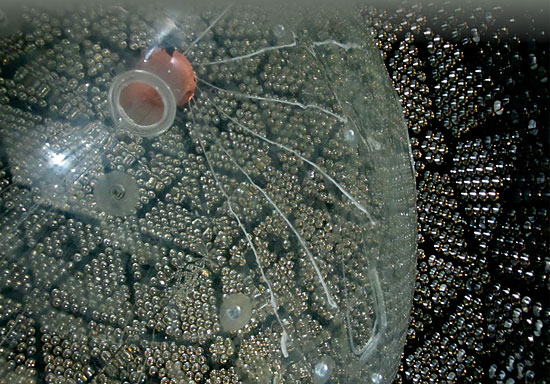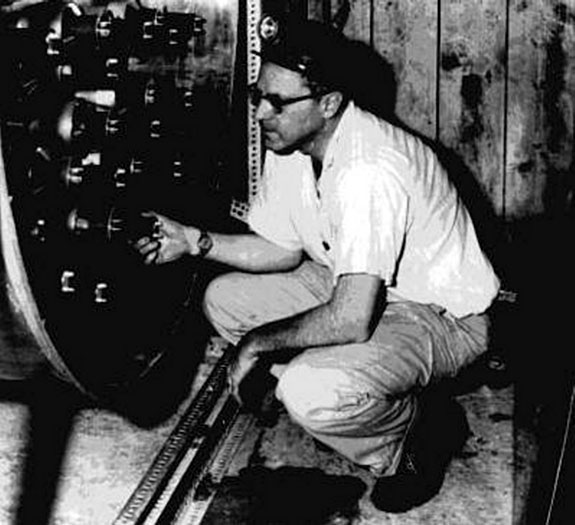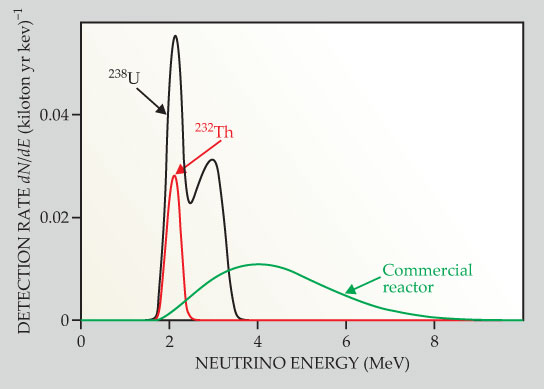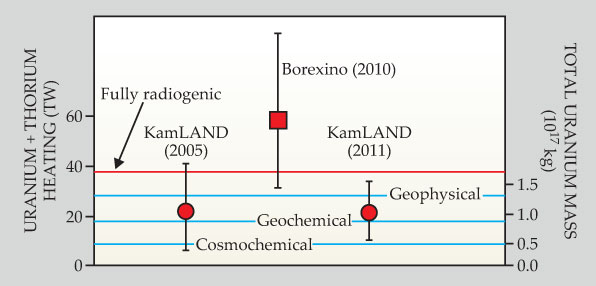The many uses of electron antineutrinos
DOI: 10.1063/PT.3.1477
The kind of neutrinos emitted in nuclear beta decay—namely electron antineutrinos (
Two kiloton-sized

Figure 1. Interior of the SNO+ antineutrino detector nearing completion at the Sudbury Neutrino Observatory in Ontario, Canada. The foreground acrylic vessel that will hold almost a kiloton of liquid scintillator is surrounded by thousands of phototubes that will look for light flashes signaling antineutrino interactions in the liquid. The detector will be used for particle physics and geology.

All neutrino varieties are impervious to the electromagnetic and strong-nuclear forces, and are at least a million times lighter than the electron (see the
Of course, the various neutrino mass and flavor eigenstates, and their metamorphoses, are themselves subjects of intense study by particle physicists. But in this article, we focus primarily on the usefulness of neutrinos for geology and nuclear security.
Seeing neutrinos
Neutrinos were first hypothesized in 1930 by Wolfgang Pauli to conserve momentum in beta decay. He presumed that they were massless and undetectable—except as missing momentum. In 1956, however, Frederick Reines, Clyde Cowan, and coworkers achieved the first sighting of neutrinos, specifically electron antineutrinos, with a cubic-meter-size detector placed about 10 meters from a nuclear reactor at the Savannah River power plant in Georgia (see figure 2). Thus began the science of detecting neutrinos and their use for monitoring what’s going on inside nuclear reactors.

Figure 2. Frederick Reines in 1953 with a component of the 250-kg liquid-scintillator detector with which he and Clyde Cowan would demonstrate the existence of neutrinos three years later.

A decade later, Raymond Davis’s experiment deep inside the Homestake mine in Lead, South Dakota, first detected neutrinos from the Sun—in that case νes. But he saw only about a third as many as solar models predicted. That shortfall was the first indication of a phenomenon now well attested by many detector experiments: neutrino oscillation, the oscillatory metamorphosis of neutrino flavors. 1
In 2003 the KamLAND (Kamioka Liquid AntiNeutrino Detector) collaboration, whose detector inside the Kamioka zinc mine in Japan monitors dozens of reactors near and far, reported that, like solar neutrinos, the
Putting them to work
The KamLAND experiment was designed to study fundamental neutrino physics by monitoring
between an incident
But KamLAND can also monitor the actions of those who operate reactors. Early in a power reactor’s fuel cycle, its rods produce weapons-grade plutonium along with abundant other fissile and fission isotopes. Legitimate power reactors burn the rods until they are largely (but not entirely) depleted of fissile material—typically in about 18 months. A telltale signature of surreptitious use of reactors to manufacture weapons-grade material is frequent shutdowns to allow shuffling of the rods.
Many isotopes contribute to a reactor’s

Figure 3. Expected detection rates from various sources of electron antineutrinos (

KamLAND’s ability to detect geoneutrinos is a byproduct of its primary particle-physics purpose: recording the flavor-oscillation disappearance of
Borexino, the only other detector so far in the geoneutrino business, is smaller than KamLAND. But in a tunnel under the Gran Sasso d’Italia, the highest peak in the Apennines, it’s much less plagued by reactor backgrounds; the nearest reactor is 1000 km away. The Borexino team reported its first geoneutrino measurements 5 in 2010. So geology now has the benefit of two large detectors sited in markedly different geological environments, contending with different background issues.
Unlocking Earth’s secrets
One can think of Earth as an “antineutrino star” emitting about 6 million
Geoneutrino observations offer an opportunity to establish independently the absolute amount of U and Th in Earth’s crust and mantle, thus settling a 150-year-long discussion about the Earth’s internal heat sources initiated by Lord Kelvin. Increasingly precise measurement of the surface flux of geoneutrinos will make it possible to discriminate between competing models of the planet’s bulk composition. The data will test models that consider various accretion materials that went into Earth’s formation—for example, the primitive, undifferentiated material that formed in the Sun’s protoplanetary nebula 4.5 billion years ago and now shows up in chondritic meteorites.
The data will also test models that predict the existence of local areas of enriched radioactivity in the mantle, some of which may have been sequestered to the core–mantle boundary early in Earth’s history. Geoneutrino results will also address models that predict the fractional contribution of radioactive heating to the planet’s total heat flow. There’s also the open question of the level of radioactivity—presumably small—in Earth’s core. (See the article by Bernard Wood in PHYSICS TODAY, December 2011, page 40
Many other debates in geodynamics can be narrowed and reshaped by geoneutrino data collected on land and in the oceans. One wants to know how much, if any, of Earth’s radiogenic power is driving plate tectonics or running the geodynamo in the liquid-iron core. Knowing how much radioactive power Earth generates would, in turn, tell us about the building blocks that made the planet and the initial conditions of its formation. A subject of lively debate is what proportion of the surface heat flow comes from present radioactive decay and how much is from primordial heat sources such as the kinetic energy of accretion bombardment, ancient radioactivity, and the gravitational energy of core formation by percolation of molten metal from the outer layers.
Earth radiates away its internal heat at 46 ± 3 terawatts.
6
From estimates of Th, U, and potassium in the continental crust, one can conclude that about 8 TW of that heat is from 40K decay.
7
The remaining radiogenic heating is presumed to come almost entirely from the decay chains of 238U and 232Th in roughly equal measure. The Th/U atomic abundance ratio (about 4:1) is taken from the impressively uniform compositions of chondritic meteorites. The K/U ratio is 104:1, but most of that is stable 39K. Unfortunately, the entire
Subtracting the 8-TW contribution from 40K, we need to explain the source of the remaining 38 TW. What fraction of that deep power is radiogenic? The answer relates to compositional models of Earth’s formation.
How much K, Th, and U is there below the crust? Earth-formation models are constrained by seismic and geodetic data that describe the planet as it is today. Determining its earliest stages is a challenge. Three different approaches are used for estimating Earth’s composition: cosmochemical, geochemical, and geophysical. Each has its strengths and weaknesses. Together they narrow the total mass of U in the crust and mantle—a proxy for the planet’s total radiogenic heat production—to somewhere between 5 × 1016 and 1.3 × 1017 kg. The remainder of heat production, from Th and K, is projected from the Th/U and K/U abundance ratios. (Uranium is, by the way, the scarcest naturally occurring element in the solar system.)
The cosmochemists seek to reconcile the chemical and isotopic compositions of chondritic meteorites with those of Earth. Noting that so-called enstatite chondrites—a rare subclass characterized by its paucity of oxides—share with Earth the same isotopic compositions for many elements, one concludes that they are the essential building blocks of Earth’s formation. That argument leads cosmochemists to opt for the low end of the range of possible U abundances. 8
From the meteoritic materials, one would therefore conclude that the lower two-thirds of the mantle is markedly different, chemically and mineralogically, from the upper mantle. But many geologists reject the idea of such large-scale heterogeneity in the mantle as inconsistent with seismological images of subducting oceanic plates that plunge into the deep mantle, continually stirring the entire convecting mantle.
An alternative modeling approach is based on using actual geochemical samples of the mantle and crust to estimate the concentration of elements in the primitive mantle before the crust was formed. 9 Those models predict about 8 × 1016 kg U in the crust and mantle, and they conclude that the mantle has a relatively homogeneous composition throughout. They are consistent with elasticity models of the mantle and with broader chondritic models that deemphasize the enstatites. The shortcoming of the geochemical approaches, however, is that rocks that emerge from the mantle only sample depths of a few hundred kilometers and do not reveal whether they had resided at greater mantle depths in the past.
Finally there are the geophysical models. They use present-day boundary conditions given by the measured surface heat flux to find solutions for the planet’s thermal evolution that specify the relative contributions of primordial heat and ongoing radiogenic heat production. 10 Those models parameterize mantle convection in terms of thermal and momentum diffusivities, buoyancy, and viscosity. Typically, the geophysics models predict the highest U abundances for the mantle, and they conclude that more than half the present heat flow is radiogenic. Thus they are at odds with the cosmochemical and geochemical models with regard to the structure, abundance, and distribution of Earth’s heat-producing elements.
Progress
Since the first geoneutrino sighting at KamLAND in 2005, there have been considerable advances. As shown in figure 4, KamLAND’s 2011 results have much improved statistics. 4 Its new value for the combined U and Th contribution to Earth’s heat flux remains consistent with all three broad classes of Earth models. But it now excludes, with 97% confidence, a fully radiogenic model that presumes that all the planet’s primordial heat is long gone and attributes Earth’s entire heat flux to current radioactivity. The 2010 Borexino measurement, with its capacious error bar, had been compatible with that fully radiogenic model, but it’s also compatible with the new KamLAND measurement.

Figure 4. Heating of Earth by uranium and thorium decay, as deduced from three geoneutrino experiments.

Soon a third geoneutrino detector will come on line, the SNO+ detector deep inside a nickel mine in Sudbury, Ontario (see figure 1). SNO+ is a thoroughly revamped version of the Sudbury Neutrino Observatory’s heavy-water solar-neutrino detector (see PHYSICS TODAY, July 2002, page 13
Detectors are getting progressively better. They’re being made with purer materials that minimize backgrounds from radioactive contaminants. Borexino holds less than half a kiloton of scintillator, but the exquisite purity of the liquid and its vessel allow it to detect neutrinos by elastic scattering as well as inverse beta decay. As clean as Borexino, the SNO+ detector, 2 km underground, will be the deepest of the geoneutrino detectors. Depth is crucial for minimizing backgrounds due to cosmic-ray muons.
Planned large-scale experiments propose to include developments in detector technology that have applications in particle physics, geology, national security, and astroparticle physics. A group at the Technical University of Munich is planning a gargantuan 50-kiloton scintillation detector called LENA (Low Energy Neutrino Astronomy). 12 A proposed US experiment called Hanohano (Hawaiian Anti-Neutrino Observatory, stated twice in Hawaiian linguistic tradition) envisages a mobile detector, with between 10 and 50 kilotons of liquid scintillator, that would operate on the sea floor. It could be deployed out in the middle of the ocean, far removed from continental crustal radioactivity—or at different distances from specific nuclear reactors. 13 The former deployment would address radioactivity in the mantle as distinguished from the crust, and the latter would facilitate the study of neutrino oscillation as a function of distance from the source.
A particularly interesting deployment of such a mobile detector would be in the middle of the South Pacific, roughly equidistant from South America, Australia, and the core–mantle boundary. Out there above the thin oceanic crust, which is relatively free of radioactivity, it would have better access than land-based facilities to the mantle’s radioactivity.
Supernovae generate
Achieving directionality
The positron created in the inverse-beta-decay reaction produces a prompt light flash as it moves just a few millimeters through the scintillator and then annihilates with an electron. The flash’s intensity provides a rough measure of the instigating neutrino’s energy. About 0.2 ms later, the much heavier neutron, having wandered about a meter with very little of the incident
Identifying the source direction of a
We hope that the CHOOZ and Palo Verde demonstrations are only the beginning. The University of Hawaii contingent of the KamLAND collaboration is developing a tiny neutrino detector that can localize the
Directionality greatly enhances the ability to monitor reactors from afar by identifying the neutrinos one wants and rejecting those coming from elsewhere. It would let geologists make tomographic neutrino images of the mantle that point out areas of high Th and U accumulation. And particle physicists want anything that enhances the signal-to-noise ratio of neutrino-oscillation data. Directionality might even allow actual imaging of a reactor’s fusion furnace.
Monitoring reactors
Small detectors are being developed specifically for monitoring
Endorsement of modern compact, standalone neutrino detectors by the International Atomic Energy Agency would represent a major step forward. More conventional monitors have to tap into a reactor’s plumbing or other infrastructure. It’s thought that neutrino detectors near cooperating reactor facilities will become commonplace. Such nonadversarial monitoring might offer economic benefit by helping operators tune the reactor for maximal power output. In disasters like the March 2011 earthquake in Japan, neutrino detectors might provide the signal for timely reactor shutdown.
There’s much that geologists don’t yet understand about the source of Earth’s deep heat. We do know that radioactivity has been and remains a significant contributor. But recent results demonstrate that the planet’s primordial heat is not yet exhausted.
4
The biggest unknown is the amount of radioactive material inside Earth, and that’s where
The ghostly neutrino has gone from being a peripheral curiosity in particle physics to playing a prominent role in cosmology and in the quest for a comprehensive theory of the fundamental forces. Now tools originally developed for particle physics and astrophysics are being adapted to probe the otherwise inaccessible deep interior of our planet and to provide unimpeachable monitoring of nuclear reactors.
Neutrinos, antineutrinos, and beta decay
The standard model of particle theory admits three flavors of neutrinos: νe, νμ, and ντ, associated, respectively, with the three charged leptons: the electron, the muon, and the tau. The model, regarding neutrinos as Dirac fermions, assigns each flavor f a distinct antineutrino (
Beta decay, in which a neutron becomes a proton, is common for many long-lived, neutron-rich isotopes of, for example, uranium, thorium, and potassium. The figure shows this metamorphosis at a more fundamental level: a down quark d in the neutron becomes an up quark u by emitting a virtual W− boson that instantly decays into an electron and a
It’s widely conjectured that the neutrino is not, in fact, a Dirac fermion but rather a Majorana fermion that’s its own antiparticle. (See the article by Alfred Goldhaber and Maurice Goldhaber in PHYSICS TODAY, May 2011, page 40

References
1. Y. Fukuda et al., Phys. Rev. Lett. 81, 1562 (1998); https://doi.org/10.1103/PhysRevLett.81.1562
Q. R. Ahmad et al., Phys. Rev. Lett. 89, 011302 (2002). https://doi.org/10.1103/PhysRevLett.89.0113022. K. Eguchi et al., Phys. Rev. Lett. 90, 021802 (2003). https://doi.org/10.1103/PhysRevLett.90.021802
3. T. Araki et al., Nature 436, 499 (2005). https://doi.org/10.1038/nature03980
4. A. Gando et al., Nat. Geosci. 4, 647 (2011). https://doi.org/10.1038/ngeo1205
5. G. Bellini et al., Phys. Lett. B 687, 299 (2010). https://doi.org/10.1016/j.physletb.2010.03.051
6. C. Jaupart, S. Labrosse, J.-C. Mareschal, in Treatise on Geophysics, vol. 7, D. Bercovici, G. Shubert, eds.,Elsevier, Amsterdam (2007), p. 253.
7. R. Arevalo, W. F. McDonough, M. Luong, Earth Planet. Sci. Lett. 278, 361 (2009). https://doi.org/10.1016/j.epsl.2008.12.023
8. M. Javoy et al., Earth Planet. Sci. Lett. 293, 259 (2010). https://doi.org/10.1016/j.epsl.2010.02.033
9. W. F. McDonough, S.-S. Sun, Chem. Geol. 120, 223 (1995). https://doi.org/10.1016/0009-2541(94)00140-4
10. G. Schubert, D. Stevenson, P. Cassen, J. Geophys. Res. 85, 2531 (1980). https://doi.org/10.1029/JB085iB05p02531
11. M. C. Chen, Earth Moon Planets 99, 221 (2007). https://doi.org/10.1007/s11038-006-9116-4
12. M. Wurm et al., Acta Phys. Polon. B 41, 1749 (2010).
13. J. G. Learned, S. T. Dye, S. Pakvasa, in XII International Workshop on Neutrino Telescopes, Venice, 2007, H. Baldo Ceolin, ed.,Papergraf, Padua, Italy (2007), p. 235.
More about the Authors
William McDonough is a professor of geology at the University of Maryland, College Park. John Learned is a professor of physics at the University of Hawaii, in Honolulu. Stephen Dye is a professor of physics at Hawaii Pacific University, Kaneohe.




